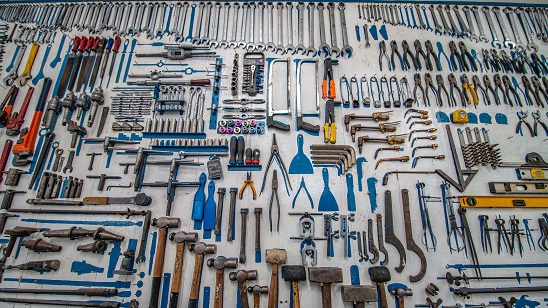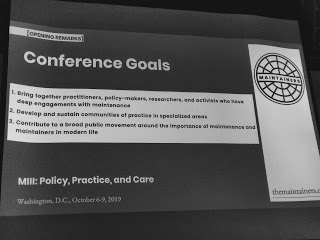Maintenance in 2019
Posted on 15 November 2019
Maintenance in 2019
 Photo by Cesar Carlevarino Aragon on Unsplash
Photo by Cesar Carlevarino Aragon on UnsplashBy Dr Laura James, Software Sustainability Institute Fellow
This blog post was first published on Dr Laura James's own blog on 13 October 2019.
It’s been two weeks of intensive thinking about maintenance.
First we held the second Festival of Maintenance in Liverpool on the 28th September; then I travelled to Washington DC for Maintainers III last week. You can find a summary of the 2019 Festival (and where it came from) over on the Maker Assembly blog. Many thanks for the support over the last two years, Maker Assembly! 2019 was my first Maintainers event, made possible by a Fellowship from the Software Sustainability Institute.
Sitting down to write up MIII is quite an intimidating task, as there was so much material covered and a great richness to the ideas we explored. Both events brought together diverse people and communities around a sense of a shared ideal - that there is great value in maintenance that we are not recognising sufficiently today.
 It was good to be at an event with clear goals
It was good to be at an event with clear goalsAndy Russell managed to pull together three themes for his closing summary at MIII - a tough task, with two and a half days and four tracks to cover. The first was about cultures of maintenance - the status of maintenance labour, the values intrinsic in this work, and awareness of maintenance in our world. The event (workshop? conference? unconference?) highlighted the importance of telling stories about maintainers and maintenance, and reflecting on our own time, labour and experiences and how they are affected by maintenance. It was clear that our society (in developed, Western/Northern contexts) needs to think ecologically, change our expectations, and recognise that crisis is already visibly here, with fire and flood and more. (The California power cuts were announced very shortly after Deb Chachra’s outstanding keynote on infrastructure and rights to power). Patterns of exploitation, past and present, along gender, race and global inequality lines were discussed, along with the need to change prevailing modes of behaviour, adopting different models for community, governance, and involvement in maintenance.
A second theme was how we pay for things - economics threaded through many of the sessions, particularly the contrast between capital and operating costs, and how little sense our current models make if we consider climate, or intergenerational justice. We are simply not accounting for or anticipating, let alone paying, the full costs of things. The body of expertise buried in organisations such as facilities management departments was noted, and the need for more stewardship and conservation as we cannot continue to have so many new things. (One speaker highlighted a depressing case of a campus sorority building commission, where the intent from the start was for the building to be demolished as soon as the bond used to fund its construction matured.) Tuesday’s lunchtime keynote by Chuck Marohn, author of Strong Towns, captured this well with a range of examples where today’s financial systems are failing towns and cities, where ongoing maintenance bills cannot be funded by the taxes resulting from new developments. There were some beginnings of conversations around senescence and death, when and how to stop maintaining. Weeding is a form of maintenance, as is the curation of library collections, and the removal of ‘cruft’ in software. It’s time consuming, laborious, and necessary. We may need to stop maintaining things at a larger scale, too.
The third theme Andy identified was the need to connect research and practice. I would interpret this a little differently, looking instead to a more general need to connect across disciplines and sectors. There is a moral case for maintenance and maintainers, an ethics of care, with economic and environmental considerations; but more data (both qualitative and quantitative) is needed to make this persuasive and to tackle the complexity of finding ways to change and evolve today’s systems. This points to a need to raise and share more specific research questions, and also for more collaborations between groups, be they researchers and advocates, or other communities. (Right to repair was noted as a good example of building alliances.)
Stories are great. How can we leverage them to resource maintenance where it’s needed most?
At MIII, a facilities manager at a major US university talked about how they received beautiful Dale Chihuly glass sculptures as a gift from an alumnus, which were mounted and lit in a building foyer. The pieces have created ongoing costs and troubles - there is only one permitted cleaner, who visits every two years; the lighting is in a location that cannot be reached by ladder and there is no cherry-picker access, and so all the bulbs have now blown, awaiting one day when scaffolding can be set up to allow their replacement. It doesn’t seem like these things were considered when the gift was made. A contrasting story came from the Smithsonian, resisting pressure to create new museums (which would create significant ongoing costs, even after the funding drive to build them); saying no was the right thing to do when considering maintenance, but left stories potentially unshared. They addressed this by adding content to existing museums.
We know some stories resonate more than others. Wildlife conservation organisations find it easier to fundraise for cute ambassador species such as pandas; what are the ambassadors for maintenance? There’s a need to remember that celebrating one-off, “model” maintainers neglects the vast underclass of maintainers - how can we showcase the collective, whilst retaining the appeal of ‘hero’ narratives?
Some maintenance is performed in public, and celebrated; such as the keepers who feed penguins at the aquarium. Some maintenance is performed in public and people turn away. An interesting example was the way Disney organises maintenance at theme parks - repair and maintenance are ongoing, present in the spaces of the parks, performed when needed and to a high standard. You see the workers fixing potholes very quickly after they arise, whilst the park is open. Stewart Brand, of the Long Now Foundation, asked if next time we could take a field trip around the conference hotel, hosted perhaps by the facilities manager - or, perhaps better, a room cleaner, so we could see the periodicity of maintenance, the physical plant, the materials and tools. What does a good hotel guest look like, or a bad one? Room cleaners get tips, but dishwashers do not - both maintain.
From the Festival, I was particularly struck by the idea that the wartime slogan “make do and mend” had devalued repaired clothing, making items seem like compromise instead of a bond forged with clothing through the love of undertaking repair. Combined with new access to increasingly cheap, mass manufactured clothing from factories, this resulted in ‘fast fashion’ (and this is now hitting more people - see this graph from a longer report).
It was good to see class discussed at MII as well as other forms of injustice. Not all maintainers are lower class, lower status. The maintainers of open source software are held in high regard - but this role is often restricted to those with the privileges of free time (or financial security) for extensive volunteer labour. Repairing everyday items is often costly and time-consuming, you need skills and equipment that many will lack.
There were calls for a more diffuse understanding of the role of maintenance for everyone, not just those whose jobs may involve it. We need normalised, positive depictions of maintainers, and greater awareness of how much labour maintenance is. Very few engineering courses describe maintenance, focussing instead on the design and construction of new things, despite the fact that most engineers will be working with existing systems created by others much of the time. How can we build structures into projects where maintenance has played a role, to capture the value and recognise it, and share the wisdom arising from it?
The Maintainers community includes practitioners and researchers in each of the track areas (transportation, software, information) as well as artists, nurses, technologists, facilities managers, architects, historians, activists, union organisers, gardeners, conservationists, repairers and more. The Festival of Maintenance community can add cleaners, archivists, data scientists, creative professionals, writers, makers, community coordinators, engineers, carers, curators, textile workers. I heard attendees at both events saying that they felt at home, amongst their people, or 'my tribe'.
I couldn’t say whether there’s a Maintenance Movement or not. Whilst there is definitely a sense of a change to be made, it’s not clear exactly what a future system or “maintenance economy” would look like, or what the steps are to get there. Nonetheless, there are people from all kinds of backgrounds and working in all kinds of contexts who believe there is great value in maintenance, and they are starting to gather and connect.
Thank you to everyone who made MIII happen, especially the organisers and sponsors and track chairs, plus also those who attended and shared their stories and ideas. Lee Vinsel, Andy Russell, and Jessica Meyerson, the co-directors of the Maintainers, were especially welcoming - thanks again!

